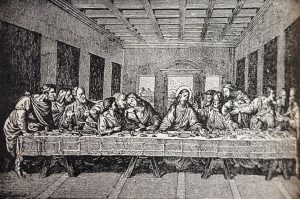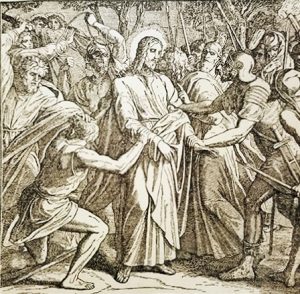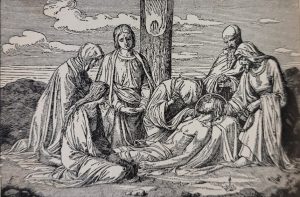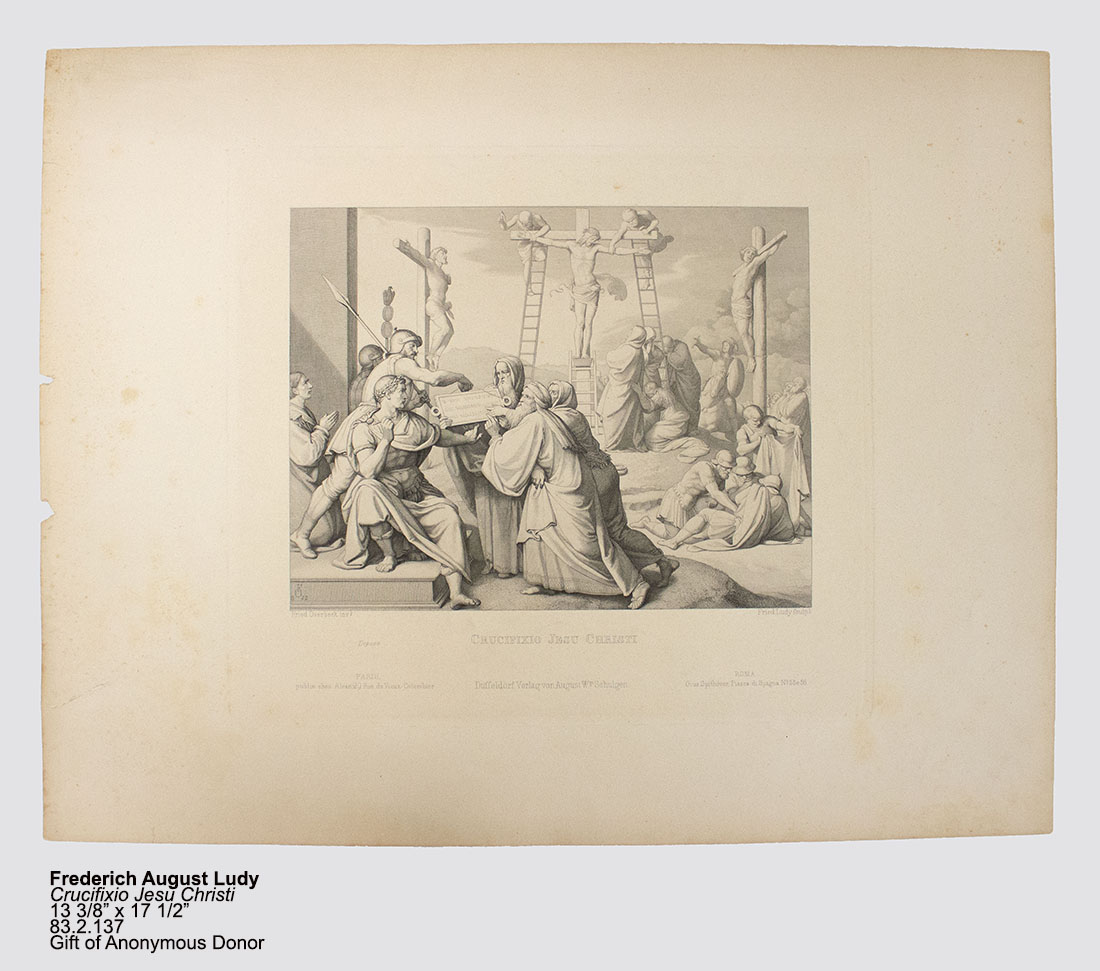Image: “Christ’s Triumphal Entry to Jerusalem,” from:
Bible History, Containing the Most Remarkable Events of the Old and New Testaments
By Right Reverend Richard Gilmour, D.D., Bishop of Cleveland, Ohio.
New York: Benzinger Brothers, 1894
Courtesy of Archives and Special Collections
HOLY WEEK 2021
The final week before Easter – spanning Palm Sunday through Holy Saturday – is known as Holy Week, a time when Catholics gather to remember and participate in the Passion of Jesus Christ. The Passion is the final period of Christ’s life in Jerusalem, commencing when he arrived in the city until He was crucified.[1] Holy Week provides an opportunity to reflect upon Jesus’ crucifixion, a sacrifice for all of humanity so that we might be redeemed through his suffering and death.[2]
On Palm Sunday, the beginning of Holy Week, Jesus entered the city of Jerusalem. In the image “Christ’s Triumphal Entry to Jerusalem” above, we see Jesus’ humble arrival into the city on the back of a donkey to observe Passover. According to the Gospel account, he was greeted by crowds of people who spread their cloaks and laid palm leaves in his path and proclaimed him the Son of David (Matthew 21:5).[3] The palm branch is an ancient symbol of victory, goodness and well-being and Jesus’ followers welcomed him as their Messiah by waving palm branches and placing them on the ground along the route.[4]
Holy Thursday celebrates the institution of the Eucharist as the true body and blood of Jesus Christ and the establishment of the sacrament of the priesthood. During the Last Supper, Jesus offers himself as the Passover sacrifice, the sacrificial lamb, and teaches that every ordained priest is to follow the same sacrifice in the exact same way. The Holy Thursday Liturgy takes place at sundown, marking the end of Lent and the beginning of the sacred “Triduum,” or three days of Holy Week – the three holiest days in the Catholic Church.[5]
priesthood. During the Last Supper, Jesus offers himself as the Passover sacrifice, the sacrificial lamb, and teaches that every ordained priest is to follow the same sacrifice in the exact same way. The Holy Thursday Liturgy takes place at sundown, marking the end of Lent and the beginning of the sacred “Triduum,” or three days of Holy Week – the three holiest days in the Catholic Church.[5]
Jesus was arrested after the Passover Seder, or Last Supper, during which he gave his final sermon. According to the canonical gospels, his arrest took place in Gethsemane, a garden which scholars believe was an olive grove. Jesus was there with his disciples to pray after the seder when he was arrested by temple guards of the Sanhedrin, a council of elders appointed to preside over legal matters.[6] Jesus’ arrest was due to his teachings, which were opposed by the Romans.[7] Christ’s arrest, trial, conviction and crucifixion are associated with Good Friday – traditionally a day of sorrow, penance, and fasting.
Holy Saturday, also called Easter Vigil, is the traditional end of Lent. It commemorates the day that Jesus Christ’s body was entombed. This is the day before Easter, which celebrates Jesus’ Resurrection, on the third day after his crucifixion.[8]
 On Holy Saturday evening, a priest or deacon carries a Pascal Candle in procession into a darkened church. A new fire, symbolizing our eternal life in Christ, is kindled to light the candle. The candle, representing Christ himself, is blessed by the priest.[9]
On Holy Saturday evening, a priest or deacon carries a Pascal Candle in procession into a darkened church. A new fire, symbolizing our eternal life in Christ, is kindled to light the candle. The candle, representing Christ himself, is blessed by the priest.[9]
The engraved images accompanying this post are from Bible History, Containing the Most Remarkable Events of the Old and New Testaments published in 1894 by Benzinger Brothers of New York. This rare book is one of numerous antique volumes available for research in the Department of Archives and Special Collections.

The images and materials shown here are but a small part of the vast patrimony available to students, faculty and researchers. For access to this or other objects in our collections, complete a research request form to set up an appointment or contact us at 973-761-9476.
[1] https://www.saintpats.org/parish/holy-week/, accessed 3/24/2021.
[2] https://nwcatholic.org/voices/cal-christiansen/why-did-jesus-have-to-die-on-the-cross, accessed 3/29/2021.
[3] https://www.britannica.com/story/holy-week, accessed 3/29/2021.
[4] https://www.learnreligions.com/palm-branches-bible-story-summary-701202, accessed 3/24/2021.
[5] https://www.catholicnewsagency.com/resources/holy-week/holy-thursday/the-significance-of-holy-thursday, accessed 3/29/2021.
[6] https://en.wikipedia.org/wiki/Arrest_of_Jesus#:~:text=It%20occurred%20shortly%20after%20the,chief%20priests%20to%20arrest%20Jesus, accessed 3/29/2021.
[8] https://www.britannica.com/story/holy-week, accessed 3/29/2021.
[9] https://www.catholicnewsagency.com/resources/holy-week/holy-saturday/the-paschal-candle, accessed 3/29/2021.


